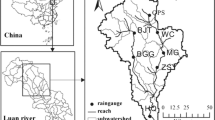Abstract
Watershed exposure caused by the use of pesticide in farmland has become a major environmental concern. Currently, there are two major approaches to quantify the watershed exposure: monitoring and modeling. Watershed monitoring is expensive, and short-term monitoring is difficult to be used to address potential long-term exposure variability. Model simulation is widely used because not only can it save time and efforts, but it can also simulate the environmental transport process of pesticide over a long time frame to better understand temporal variability. Research on application of commonly used pesticide exposure assessment models such as PRZM, RICEWQ on watershed scale has found that those models need to be coupled together with waterbody models to assess pesticide exposure at the watershed level, and they are applied on a single crop in targeted area within a watershed, failing to consider the diversity of regional and watershed cropping conditions. To address pesticide exposure assessment in different waterbodies after application on multiple crops within a watershed, this study coupled PRZM, RICEWQ, and SWAT models simultaneously in North Tiaoxi watershed. PRZM model and RICEWQ model were used to simulate the exposure of pesticides in dryland and rice paddies separately, and the pesticide masses through runoff, overflow, spray drift, and other routes simulated by the above two models were set as the input of SWAT model which could simulate hydrology and pollutant transport at watershed scale. Pesticide use, cropping, hydrology, and watershed data were collected, and parameterized for exposure modeling of carbaryl in the North Tiaoxi River after uses on orchard, corn, and rice within the watershed. Model predictions showed high degree of agreement between the simulated results and the field monitoring data. The coupled PRZM, RICEWQ, and SWAT model could simulate reasonably well pesticide exposures in waterbodies with applications on multiple crops within a watershed.







Similar content being viewed by others
References
Arnold JG, Srinivasan R, Muttiah RS, Williams JR (1998) Large area hydrologic modeling and assessment part I: model development. J Am Water Resour Assoc 31(1):73–89
Carsel RF, Smith CN, Mulkey LA, Dean JD, Jowise P (1984) User’s manual for the pesticide root zone model (PRZM): release 1. Athens, GA: EPA-600/3-84-109. U.S. Environmental Protection Agency
Cheng Y, Zhou J, Shan Z (2012) Aquatic eco-risk and health risk assessment of application of pesticide in rice paddy in Dongtiaoxi watershed based on modified RICEWQ-EXAMS model [J]. J Ecol Rural Environ (5):579–586
Dasgupta S, Cheplick JM, Denton DL, Troyan JJ, Wiliams WM (2008) Predicted runoff loads of permethrin to the Sacramento River and its tributaries. In: Gan J, Spurlock F, Hendley P (eds) Synthetic pyrethroids, occurrence and behavior in aquatic environments. Oxford University Press, Oxford
Dimitrios GK, Capri E, Mourkidou EP (2006) Basin-scale risk assessment in rice paddies: an example based on the Axios River basin in Greece [J]. Vadose Zone J 5:273–282
Ioannis KK, Dimitra GH, Triantafyllos AA (2006) The status of pesticide pollution in surface waters (rivers and lakes) of Greece part I review on occurrence and levels [J]. Environ Pollut 141(3):555–570
Luo Y, Zhang M (2010) Spatially distributed pesticide exposure assessment in the Central California, USA [J]. Environ Pollut 158:1629–1637
NRCS (2017) United States Department of Agriculture – Natural Resources Conservation Service. Saturated Hydraulic Conductivity. https://www.nrcs.usda.gov/wps/portal/nrcs/detail/soils/survey/office/ssr10/tr/?cid=nrcs144p2_074846. Accessed 9 January 2017.
Ollers S, Singer HP, Fassler P et al (2001, 91l) Simultaneous quantification of neutral acidic pharmaceuticals and pesticides at the low-ng/L level in surface and waste water [J]. J Chromatogr A 911(4):225–234
Parker R, Arnold JG, Barrett M, Burns L, Carrubba L, Neitsch SL, Snyder NJ, Srinivasan R (2007) Evaluation of three watershed-scale pesticide environmental transport and fate models. J Am Water Resour Assoc 43:1424–1443
Song N, Bu Y, Shan Z (2010) A review of studies on pesticide pollution in surface water [J]. J Ecol Rural Environ 26(supplement):49–57
Suarez LA (2006) PRZM-3, A model for predicting pesticide and nitrogen fate in The crop root and unsaturated zones: user’s manual for release 3.12.2, EPA document number # 600/R-05/111. National Exposure Research Laboratory, U.S. Environmental Protection Agency, Athens, GA
Wang W, Huang C, Zhang M et al (2013) Study on status of regional water pollution by pesticides in China [J]. Environ Protec Sci 39(5):5–9
Williams WM, Ritter AM, Zdinak CE, Chaplick JM (2008) RICEWQ: pesticide runoff model for rice crops. Users manual and program documentation. Version 1.7.3. Waterborne Environmental, Inc. Leesburg, A 20175, USA
Author information
Authors and Affiliations
Corresponding author
Additional information
Responsible editor: Marcus Schulz
Publisher’s note
Springer Nature remains neutral with regard to jurisdictional claims in published maps and institutional affiliations.
Rights and permissions
About this article
Cite this article
Cheng, Y., Zhou, J., Liao, J. et al. Coupled modeling using PRZM/RICEWQ and SWAT for the North Tiaoxi Watershed. Environ Sci Pollut Res 27, 12635–12645 (2020). https://doi.org/10.1007/s11356-019-06418-x
Received:
Accepted:
Published:
Issue Date:
DOI: https://doi.org/10.1007/s11356-019-06418-x




